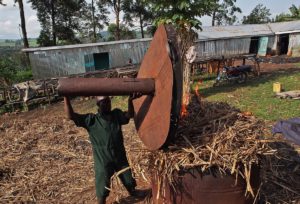Source: psmag.com
Published: November 8, 2016

A worker burns sugarcane waste, part of the process in making biochar, at the Eco Fuel Africa factory in Lugazi, Uganda
Climate delegates from around the globe have converged on the COP22 Village in Marrakech, Morocco, to hammer out the details of implementing the Paris Agreement. We already know that nations’ Intended Nationally Determined Contributions, as they stand now, will not be enough to meet the goals of the agreement, and it’s widely accepted that, in order to keep warming below two degrees Celsius, we’ll have to deploy technologies to remove carbon from the atmosphere during the second half of the century.
There has been much ado about flashier carbon-capture systems, like geologic sequestration, which involves collecting carbon dioxide and injecting it deep below the Earth’s surface — into depleted oil or gas wells, for example. But such technologies are both expensive and unproven. But in the Green Zone on Monday, Cornell University researchers explained how adding carbon to the soil could help ease climate change while also improving agriculture.
Soil management is not explicitly included in the Paris Agreement, only implicitly in the sections on forestry, according to Johannes Lehmann, a professor at Cornell’s College of Agriculture and Life Sciences. “Just as a soil scientist, that hurts,” Lehmann quipped during today’s presentation.
Soil management techniques — which include reducing soil tillage and applying biochar — have the potential to remove up to eight gigatons of carbon dioxide equivalent from the atmosphere every year. Recently, when Lehmann and his colleagues compared biochar systems — in which biomass is burned in low-oxygen stoves and added to the soil as a fertilizer — to bioenergy with carbon capture and storage systems (BECCS)—like geologic sequestration—they found that biochar systems were ultimately cheaper, more technologically feasible, and likely to be adopted earlier.
Despite the fact that BECCS could potentially lock up two times more carbon than biochar systems and provide twice the amount of bioenergy, Lehmann characterized them as “kind of a dumb idea.”
For one thing, he noted, geologic sequestration systems require a centralized location — a hole in the Earth where biomass and the carbon it holds can be dumped. That means transporting carbon to said hole to be sequestered, and potentially burning more fossil fuels in the process. For another thing, biochar systems do more than just bury carbon; biochar restores soil fertility and thus increases agricultural yields, which will ultimately help farmers feed the world’s growing population.
“Even if something like biochar doesn’t save the day … we’re still going to have good soils,” Lehmann said. “It’s a no-regret strategy.”
Improving soil fertility is huge, because soil degradation threatens 40 percent of the Earth’s land surface, according to Dawit Solomon, a senior research associate at Cornell. He took the mic after Lehmann in the Green Zone to contrast traditional agricultural practices, which have only exacerbated climate change, ecosystem degradation, biodiversity losses, and indigenous soil management systems that have long used carbon to improve soil fertility.
In particular, Solomon highlighted a study that he co-authored about African Dark Earth — a black, carbon-rich soil that stands out against the weathered, yellow and red soils of West Africa. The black soils have as much as 270 times more phosphorus than natural soils, two times more nitrogen, and many times more calcium, magnesium, and potassium — all key nutrients for healthy plant growth. Through interviews with local farmers across Ghana and Liberia, Solomon and his colleagues learned that locals created the dark earth with a mix of biomass, ash, and char from cooking, bones, and other waste. Radiocarbon dating shows that humans began transforming the soil of some current settlements in West Africa hundreds of years ago.
“No modern soil management system has managed to create something like this,” Solomon said.
For its Dark Earth study, Solomon’s team attempted to industrialize the process using locally available starting materials and a simple pyrolyzing oven to create a biochar fertilizer that could compete with expensive commercial ones. The fertilizer doubled soybean yields on local farms, and tripled maize yields.
The goal, according to Solomon, is to create technologies across all scales, from a biochar-producing cookstove for sustenance farmers to mid-level, industrial pyrolyzers to make biochar for small farms or commercial fertilizers. And the cumulative effect of many small-scale farmers taking up biochar-based systems could lead to a significant climate mitigation impact, Solomon says. As much as 85 percent of the population is dependent on agriculture, and 85 percent of agricultural input comes from smallholder farmers. “So you can imagine the scale of carbon you can sequester, just with small-scale implementation,” Solomon says.
That said, to reach the full potential of eight gigatons of carbon dioxide equivalent per year through various soil management techniques will require global implementation in all regions where these techniques may be appropriate. Lehmann and his colleagues estimate that biochar alone could account for roughly 1.8 of those gigatons annually, or about 12 percent of man-made carbon emissions.
But even if biochar ends up being less fruitful, Lehmann says, and only cuts emissions by 0.5 percent, as long as farmers see a boost in soil fertility, it’s worth investing time and money in creating biochar technologies — especially since developed nations like the United States and China are largely responsible for creating the climate that threatens agriculture across Africa today. In other words, we owe them one.“It’s doubly unfair,” Lehmann says, “and [developing countries] should get something out of it.”
